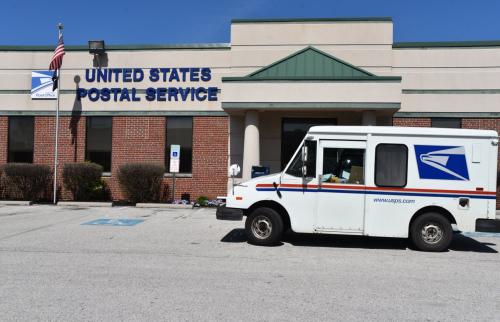It has been more than two years since the Infrastructure Investment and Jobs Act (IIJA) passed, unleashing unprecedented levels of federal funding ($850 billion-plus) for the country’s transportation, water, energy, and broadband systems. Combined with the Inflation Reduction Act (IRA) and CHIPS and Science Act, the IIJA is not only accelerating thousands of projects nationally, but also is helping create millions of jobs. Initial projections from the Biden administration and other researchers point to the potential for 1.5 million new jobs annually over the next decade, and recent estimates from the Council of Economic Advisers reveal that 670,000 construction jobs alone have been created since President Joe Biden took office in 2021—with IIJA-supported projects likely playing a key role.
But to maximize the economic reach of this historic funding, federal, state, and local leaders need to move beyond job creation numbers. They need to improve the quality of infrastructure jobs.
There are multiple guidelines and definitions around what exactly constitutes a “quality” or “good” job—from the Department of Labor and Department Commerce, to groups such as Jobs for the Future and Gallup, to several of my Brookings colleagues—but there are some common characteristics. Good jobs reach more and different individuals, including women, people of color, and younger individuals, who may traditionally be marginalized or excluded during hiring and recruitment. These jobs pay more competitive, equitable wages and offer more benefits, such as health insurance and paid leave. These jobs also support continued skills development and career growth. Job security, union representation, and safe working conditions often matter too.
Yet many infrastructure jobs do not hit these marks.
“Business-as-usual” hiring, training, and retention practices across the infrastructure sector—from transportation departments to energy utilities to water agencies to construction contractors—are often at odds with supporting job quality. For instance, infrastructure employers do not usually collaborate with workforce development organizations or educational institutions, which limits opportunities for essential on-the-job training and community engagement. Many workers are burned out and leaving these jobs for a host of different reasons. The work environment can be dangerous. And the workplace can be hostile or unwelcoming, particularly to women and other underrepresented individuals.
Perhaps most importantly, not all infrastructure jobs pay well or offer favorable working conditions. Building off of previous Brookings research on the U.S. infrastructure workforce, some of the largest infrastructure occupations have lower median wages compared to all occupations nationally. Sizable trade and logistics occupations such as material movers ($31,230 annually) fall into this category. Dispatchers in several transportation, construction, and related activities also earn low wages ($44,050). At the same time, many of these occupations can be physically dangerous and have near- or below-average unionization rates, speaking to a potential lack of workplace protections. For example, heavy truck drivers experience 93,410 injuries each year, and material movers account for more than 13% of all occupational injuries annually (301,380).
On the other hand, there are many infrastructure occupations that pay more and have relatively more favorable working conditions. Electricians earn higher median wages ($60,040 annually), have higher unionization rates (17.1%), and have relatively fewer injuries overall (17,200)—all while developing skills and gaining experience carrying out a variety of building upgrades and other climate improvements. Solar installers and wind turbine technicians are among the other higher-paid and relatively safer clean energy occupations. And telecommunications line installers represent the growing number of workers involved in deploying broadband and other digital technologies, while experiencing relatively fewer injuries and boasting higher unionization rates.
Beyond pay and working conditions, another challenge—and opportunity—across these infrastructure occupations is a lack of demographic diversity. This is most apparent when examining the underrepresentation of women versus men, which speaks to the barriers many prospective workers face entering (and staying in) these careers, as well as the potential avenues to create more accessible and welcoming careers. Nine of the 10 occupations examined above employ fewer women compared to the national average (49.6%). The most notable include many of the higher-quality jobs: electricians (2.9% of whom are women), telecommunications line installers (5.6%), wind turbine technicians (6%), and solar installers (7.5%). In other words, the highest-quality positions are often the most separated from certain job seekers—in this case, women.
Improving infrastructure job quality demands a clearer recognition of how wages, working conditions, and other workplace aspects vary across different occupations, as well as the specific barriers that individual workers face in entering them.
“Good jobs” exist in the infrastructure sector, but leaders need to boost visibility around such positions and enhance training flexibility to ensure more and different types of people can access them. For example, strengthening sector partnerships—collaborations between employers and other workforce, education, labor, and community groups—can support planning and investment around new hiring, recruitment, and training strategies. California’s High Road Training Partnerships initiative is one such model, with its clear focus on enhancing job quality and connecting more workers to good jobs. Additional supportive services (e.g., child care and transportation) are also helping workers overcome barriers, as are new federal, state, and local requirements around local hiring and community benefits agreements.
But such efforts are only the beginning for a broader suite of questions that leaders need to answer to address job quality across the infrastructure sector. These include:
- The need for statistical precision. How exactly do we define “job quality” in the infrastructure space and measure it? Even though certain job quality guidelines are available from the Department of Labor and other groups, federal, state, and local leaders still struggle to define clear statistical benchmarks of success around infrastructure workforce development, even during this critical moment of historic federal funding. Without a sense of their starting point, it will be difficult to chart progress or strengthen accountability over time.
- The need for geographic detail. How do we capture infrastructure job quality across the country, including in different states and regions? Again, national guidelines provide a rough template to gauge job quality across the country, but state and local leaders are often pursuing different types of projects, collaborating with different types of employers, and trying to reach different types of workers. Having greater geographic granularity on these details can help uncover particular hiring and training needs.
- The need for industrial specificity. How do we examine job quality across different types of infrastructure industries and occupations, including those connected to the transition to a cleaner, more resilient economy (aka “green jobs”)? Many cities lack planning around their infrastructure workforce needs, including related green jobs needs. Without a comprehensive sense of the unique barriers workers and employers face around equitable hiring and training in these industries, it will be difficult to support more durable career pathways.
While many leaders still discuss the economic potential of the current federal infrastructure moment, they need to move toward greater accountability. Money is flowing across the country and projects are underway, yet we’re still struggling to connect these investments to improved worker outcomes. Simply creating more jobs is not a substitute for expanding job quality. We must better define, measure, and address the barriers that many current and prospective infrastructure workers face, both now and in years to come.
-
Acknowledgements and disclosures
Thanks to Patrick Cook for excellent research assistance.
The Brookings Institution is committed to quality, independence, and impact.
We are supported by a diverse array of funders. In line with our values and policies, each Brookings publication represents the sole views of its author(s).




Commentary
The US needs to improve the quality of infrastructure jobs, not just create more of them
November 30, 2023